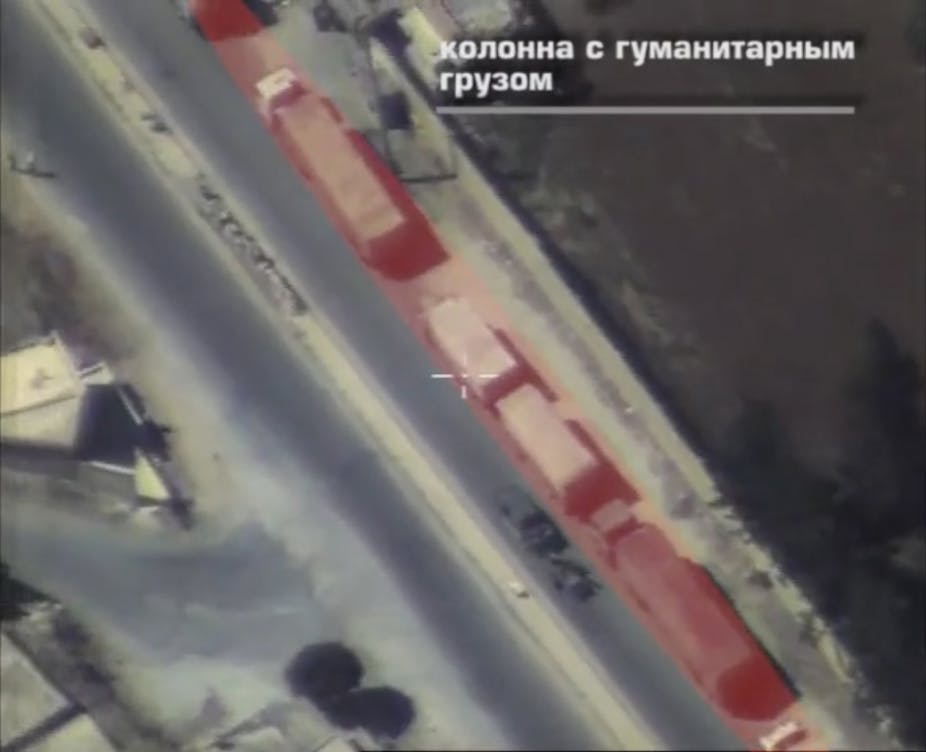Only days after the latest ceasefire agreement came into force in Syria, a United Nations aid convoy en route to Aleppo was attacked and destroyed. The UN was quick to declare this both a premeditated attack and a war crime. Citing air space intelligence, the US government released a statement accusing the Russian Air Force of responsibility, detailing the presence of two Russian Sukhoi SU-24 fighter aircraft in the area at the time of the attack.
The Russian government has denied the accusations, stating that the US has “no facts”, and responded with drone footage of the convoy allegedly showing that anti-government militias were using it as cover. At the same time, it argued that the explosion did not come from the air, and was in fact a militant attack on the convoys. (The convoy was travelling through militant-held territory at the time of the strike.)
The attack on the convoy follows the pattern of accusation and denial that has characterised the public diplomacy argument between Russia and the West, though chiefly the US: the US or UN makes a statement, and Russia responds with an equally publicly credible alternative. This back-and-forth pattern has played out many times in Syria and Ukraine, with both sides playing to their own constituencies rather than talking to each other – whether over the downing of flight MH17, Bashar al-Assad’s use of chemical weapons, or the definition of what counts as a “rebel” or “extremist” group.
This stands in contrast to the coalition forces’ response to a bombing attack that killed 60 Syrian troops on September 19, after the ceasefire began. When that incident came to light, the US, Australia and the UK all admitted they had participated in the attack, and announced investigations into the protocol and command used to identify targets.
All of this says two things. The first is that the fractured relations between Russia and the West over Syria cannot be reasonably separated from the tensions over Ukraine. With intense pressure on two fronts, the room for a common path to peace is fast disappearing.
The second is that the West has illustrated that it does not have the ability to restrain Russia in Syria, and much less in Ukraine. What ways has the West sought to restrain Russia already?
Diplomacy and sanctions
The diplomatic effort has been ongoing since Russia began its active military operations in Ukraine. The Minsk I and Minsk II agreements for peace in Ukraine were founded on a constructive diplomatic partnership between the US, EU and Russia. In fact, the principles Minsk II sets out are still used by those monitoring the Ukranian conflict to determine what qualifies as a transgression by either side.
Diplomatic efforts in Syria have been even more extensive, with co-operation at the UN Security Council and through the joint military communication centre that oversees operations against the so-called Islamic State. Such diplomacy helped bring about the latest (now failed) ceasefire, which allowed the UN aid convoy into Syria in the first place.

But as the incident involving the convoy made painfully clear, the current state of diplomacy is bad and getting worse – and all the while, it’s under pressure from the sanctions on Russia that the US and EU have maintained since Russia annexed the Crimean peninsula in 2014.
These sanctions focused on members of the Russian government and those with specific economic links to Vladimir Putin and key actors in his government, blocking international capital flows (including from oil companies) and freezing assets outside of Russia.
So far, the sanctions have been primarily intended to pressurise the elite rather than to directly affect everyday Russians, but plummeting oil and gas prices have had an impact on the cost of living, in turn putting extra pressure on Putin’s government.
Dangerous games
More controversially, the West has tried to curb Russia’s influence in both NATO and Syria by using martial deterrence.
The North Atlantic Treaty obliges all NATO members to defend and come to the aid of another should they be threatened or attacked. Since the Ukraine crisis really began to escalate, we’ve duly seen NATO troops newly positioned in Eastern Europe, an uptick in joint military exercises, and a general rise in military and defence spending.
In Syria, the issue is more complex, especially in shared airspace that both the West and Russia are using to fight IS while Russia simultaneously uses it to attack anti-government militias. The West and Russia can’t just posture; they have to both communicate and co-ordinate their various offensives to protect proxies, assets and soldiers on the ground. This is a very dangerous game to play – especially given that a new conventional war could potentially become a nuclear war.
The most effective restraint would probably be a binding agreement on a common path to peace in Syria, but the parties involved are nowhere close to agreeing on what such a peace should look like, much less the way to bring it about. The picture is simply too clouded by the rift over the Assad government’s future, the operations against IS, and the role of Iran. And all the while, the US, Europe and Russia are still facing off over the ongoing conflict in Ukraine, with all the diplomatic strain that that entails.
Russia has proven very adept at using the Syria conflict to its advantage. It’s defending a sovereign government still in power, wields overwhelming superiority in terms of air power, and it’s working with both a well-trained Syrian National Army and highly motivated pro-government militias.
But in Syria as in Ukraine, Russia will eventually seek a peace settlement. The question is whether the West will have the courage to accept it and co-operate with Russia to implement it. Easing over the difficult Russian-Western relationship will require both sides to face realities they don’t like.

